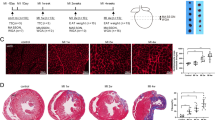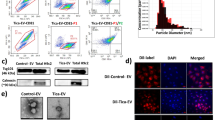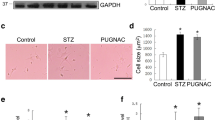Abstract
Secretory products from epicardial adipose tissue (EAT) from patients with type 2 diabetes (T2D) impair cardiomyocyte function. These changes associate with alterations in miRNA expression, including the induction of miR-208a. Recent studies suggest that activation of the cardiac-specific renin–angiotensin system (RAS) may affect cardiac energy metabolism via induction of miR-208a. This study investigated whether cardiomyocyte dysfunction induced by conditioned media (CM) from EAT-T2D involves activation of the RAS/miR-208a pathway. Therefore, primary adult rat cardiomyocytes were incubated with CM generated from EAT biopsies from patients with T2D and without T2D (ND). Exposing cardiomyocytes to CM-EAT-T2D reduced sarcomere shortening and increased miR-208a expression versus cells exposed to CM-EAT-ND or control medium. The angiotensin II receptor type 1 (AGTR1) antagonist losartan reversed these effects. Accordingly, incubation with angiotensin II (Ang II) reduced sarcomere shortening, and lowered palmitate-induced mitochondrial respiration and carnitine palmitoyltransferase 1c (CPT1c) expression in cardiomyocytes. Locked-nucleic-acid-mediated inhibition of miR-208a function reversed the detrimental effects induced by Ang II. Interestingly, Ang II levels in CM-EAT-T2D were increased by 2.6-fold after culture with cardiomyocytes. The paracrine activation of the cardiac-specific RAS by CM-EAT-T2D was corroborated by increases in the expression of AGTR1 and renin, as well as a reduction in angiotensin-converting enzyme 2 levels. Collectively, these data show that secretory products from EAT-T2D impair cardiomyocyte contractile function and mitochondrial β-oxidation via activation of the cardiac-specific RAS system and induction of miR-208a, and suggest that alterations in the secretory profile of EAT may contribute to the development of diabetes-related heart disease.







Similar content being viewed by others
References
Barbier O, Torra IP, Duguay Y, Blanquart C, Fruchart JC, Glineur C, Staels B (2002) Pleiotropic actions of peroxisome proliferator-activated receptors in lipid metabolism and atherosclerosis. Arterioscler Thromb Vasc Biol 22:717–726
Blumensatt M, Greulich S, Herzfeld de Wiza D, Mueller H, Maxhera B, Rabelink MJ, Hoeben RC, Akhyari P, Al-Hasani H, Ruige JB, Ouwens DM (2013) Activin A impairs insulin action in cardiomyocytes via up-regulation of miR-143. Cardiovasc Res 100:201–210. doi:10.1093/cvr/cvt173
Brunel-Guitton C, Levtova A, Sasarman F (2015) Mitochondrial Diseases and Cardiomyopathies. Can J Cardiol 31:1360–1376. doi:10.1016/j.cjca.2015.08.017
Bugger H, Abel ED (2014) Molecular mechanisms of diabetic cardiomyopathy. Diabetologia 57:660–671. doi:10.1007/s00125-014-3171-6
Claycomb WC, Lanson NA Jr, Stallworth BS, Egeland DB, Delcarpio JB, Bahinski A, Izzo NJ Jr (1998) HL-1 cells: a cardiac muscle cell line that contracts and retains phenotypic characteristics of the adult cardiomyocyte. Proc Natl Acad Sci U S A 95:2979–2984
Diniz GP, Takano AP, Barreto-Chaves ML (2013) MiRNA-208a and miRNA-208b are triggered in thyroid hormone-induced cardiac hypertrophy - role of type 1 Angiotensin II receptor (AT1R) on miRNA-208a/alpha-MHC modulation. Mol Cell Endocrinol 374:117–124. doi:10.1016/j.mce.2013.04.010
Fillmore N, Lopaschuk GD (2014) The link between pediatric heart failure and mitochondrial lipids. J Mol Cell Cardiol 76:71–72. doi:10.1016/j.yjmcc.2014.08.002
Goossens GH (2012) The renin-angiotensin system in the pathophysiology of type 2 diabetes. Obes Facts 5:611–624. doi:10.1159/000342776
Greulich S, Chen WJ, Maxhera B, Rijzewijk LJ, van der Meer RW, Jonker JT, Mueller H, de Wiza DH, Floerke RR, Smiris K, Lamb HJ, de Roos A, Bax JJ, Romijn JA, Smit JW, Akhyari P, Lichtenberg A, Eckel J, Diamant M, Ouwens DM (2013) Cardioprotective properties of omentin-1 in type 2 diabetes: evidence from clinical and in vitro studies. PLoS One 8:e59697. doi:10.1371/journal.pone.0059697
Greulich S, de Wiza DH, Preilowski S, Ding Z, Mueller H, Langin D, Jaquet K, Ouwens DM, Eckel J (2011) Secretory products of guinea pig epicardial fat induce insulin resistance and impair primary adult rat cardiomyocyte function. J Cell Mol Med 15:2399–2410. doi:10.1111/j.1582-4934.2010.01232.x
Greulich S, Maxhera B, Vandenplas G, de Wiza DH, Smiris K, Mueller H, Heinrichs J, Blumensatt M, Cuvelier C, Akhyari P, Ruige JB, Ouwens DM, Eckel J (2012) Secretory products from epicardial adipose tissue of patients with type 2 diabetes mellitus induce cardiomyocyte dysfunction. Circulation 126:2324–2334. doi:10.1161/CIRCULATIONAHA.111.039586
Grueter CE, van Rooij E, Johnson BA, DeLeon SM, Sutherland LB, Qi X, Gautron L, Elmquist JK, Bassel-Duby R, Olson EN (2012) A cardiac microRNA governs systemic energy homeostasis by regulation of MED13. Cell 149:671–683. doi:10.1016/j.cell.2012.03.029
Gul R, Mahmood A, Luck C, Lum-Naihe K, Alfadda AA, Speth RC, Pulakat L (2015) Regulation of cardiac miR-208a, an inducer of obesity, by rapamycin and nebivolol. Obesity 23:2251–2259. doi:10.1002/oby.21227
Gupte M, Boustany-Kari CM, Bharadwaj K, Police S, Thatcher S, Gong MC, English VL, Cassis LA (2008) ACE2 is expressed in mouse adipocytes and regulated by a high-fat diet. Am J Physiol Regul Integr Comp Physiol 295:R781–R788. doi:10.1152/ajpregu.00183.2008
Hardie DG, Pan DA (2002) Regulation of fatty acid synthesis and oxidation by the AMP-activated protein kinase. Biochem Soc Trans 30:1064–1070. doi:10.1042/BST0301064
Hue L, Taegtmeyer H (2009) The Randle cycle revisited: a new head for an old hat. Am J Physiol Endocrinol Metab 297:E578–E591. doi:10.1152/ajpendo.00093.2009
Iacobellis G (2015) Local and systemic effects of the multifaceted epicardial adipose tissue depot. Nat Rev Endocrinol 11:363–371. doi:10.1038/nrendo.2015.58
Kalupahana NS, Moustaid-Moussa N (2012) The adipose tissue renin-angiotensin system and metabolic disorders: a review of molecular mechanisms. Crit Rev Biochem Mol Biol 47:379–390. doi:10.3109/10409238.2012.694843
Lin YK, Chen YC, Chen JH, Chen SA, Chen YJ (2012) Adipocytes modulate the electrophysiology of atrial myocytes: implications in obesity-induced atrial fibrillation. Basic Res Cardiol 107:293. doi:10.1007/s00395-012-0293-1
Mandavia CH, Aroor AR, Demarco VG, Sowers JR (2013) Molecular and metabolic mechanisms of cardiac dysfunction in diabetes. Life Sci 92:601–608. doi:10.1016/j.lfs.2012.10.028
Matkovich SJ, Hu Y, Eschenbacher WH, Dorn LE, Dorn GW 2nd (2012) Direct and indirect involvement of microRNA-499 in clinical and experimental cardiomyopathy. Circ Res 111:521–531. doi:10.1161/CIRCRESAHA.112.265736
Montaigne D, Coisne A, Marechal X, Staels B, Patel VB et al (2016) ACE2 deficiency worsens epicardial adipose tissue inflammation and cardiac dysfunction in response to diet-induced obesity. Diabetes 65:e1–e2. doi:10.2337/db15-1425
Montaigne D, Marechal X, Coisne A, Debry N, Modine T, Fayad G, Potelle C, El Arid JM, Mouton S, Sebti Y, Duez H, Preau S, Remy-Jouet I, Zerimech F, Koussa M, Richard V, Neviere R, Edme JL, Lefebvre P, Staels B (2014) Myocardial contractile dysfunction is associated with impaired mitochondrial function and dynamics in type 2 diabetic but not in obese patients. Circulation 130:554–564. doi:10.1161/CIRCULATIONAHA.113.008476
Montgomery RL, Hullinger TG, Semus HM, Dickinson BA, Seto AG, Lynch JM, Stack C, Latimer PA, Olson EN, van Rooij E (2011) Therapeutic inhibition of miR-208a improves cardiac function and survival during heart failure. Circulation 124:1537–1547. doi:10.1161/circulationaha.111.030932
Mori J, Basu R, McLean BA, Das SK, Zhang L, Patel VB, Wagg CS, Kassiri Z, Lopaschuk GD, Oudit GY (2012) Agonist-induced hypertrophy and diastolic dysfunction are associated with selective reduction in glucose oxidation: a metabolic contribution to heart failure with normal ejection fraction. Circ Heart Fail 5:493–503. doi:10.1161/CIRCHEARTFAILURE.112.966705
Ouwens DM, Sell H, Greulich S, Eckel J (2010) The role of epicardial and perivascular adipose tissue in the pathophysiology of cardiovascular disease. J Cell Mol Med 14:2223–2234. doi:10.1111/j.1582-4934.2010.01141.x
Patel VB, Mori J, McLean BA, Basu R, Das SK, Ramprasath T, Parajuli N, Penninger JM, Grant MB, Lopaschuk GD, Oudit GY (2016) ACE2 deficiency worsens epicardial adipose tissue inflammation and cardiac dysfunction in response to diet-induced obesity. Diabetes 65:85–95. doi:10.2337/db15-0399
Rubler S, Dlugash J, Yuceoglu YZ, Kumral T, Branwood AW, Grishman A (1972) New type of cardiomyopathy associated with diabetic glomerulosclerosis. Am J Cardiol 30:595–602
Satoh M, Minami Y, Takahashi Y, Tabuchi T, Nakamura M (2010) Expression of microRNA-208 is associated with adverse clinical outcomes in human dilated cardiomyopathy. J Card Fail 16:404–410. doi:10.1016/j.cardfail.2010.01.002
Sugden MC (2007) In appreciation of Sir Philip Randle: the glucose-fatty acid cycle. Br J Nutr 97:809–813. doi:10.1017/S0007114507659054
Taegtmeyer H, Lubrano G (2014) Rethinking cardiac metabolism: metabolic cycles to refuel and rebuild the failing heart. F1000prime Rep 6:90. doi:10.12703/P6-90
Taegtmeyer H, McNulty P, Young ME (2002) Adaptation and maladaptation of the heart in diabetes: Part I: general concepts. Circulation 105:1727–1733
Verma SK, Garikipati VN, Kishore R (2016) Mitochondrial dysfunction and its impact on diabetic heart. Biochim Biophys Acta. doi:10.1016/j.bbadis.2016.08.021
Acknowledgements
This work was financially supported by the German Center for Diabetes Research (DZD), München-Neuherberg, Germany and a Grant to M. Blu. from the German Diabetes Foundation (Grant 367/03/15, entitled “Aktivierung des kardialen Renin-Angiotensin-Systems durch epikardiale Adipokine in Patienten mit Typ 2 Diabetes”).
Author information
Authors and Affiliations
Corresponding author
Ethics declarations
Ethical statement
All participants provided written informed consent for the collection of epicardial adipose tissue biopsies during scheduled open heart surgery. The procedures were approved by the local ethical committees of the Heinrich-Heine-University (Duesseldorf, Germany), and Ghent University (Ghent, Belgium) and conducted in accordance with the ethical standards laid down in the Declaration of Helsinki. The animal experiments were performed in accordance with the ‘Principle of laboratory animal care’ (NIH publication No. 85–23, revised 1996) and the current version of the German Law on the protection of animals. The procedures for the isolation of cardiomyocytes were approved by the local ethical committee of the Heinrich-Heine-University (Duesseldorf, Germany).
Conflict of interest
The authors declare that they have no conflict of interest.
Electronic supplementary material
Below is the link to the electronic supplementary material.
Rights and permissions
About this article
Cite this article
Blumensatt, M., Fahlbusch, P., Hilgers, R. et al. Secretory products from epicardial adipose tissue from patients with type 2 diabetes impair mitochondrial β-oxidation in cardiomyocytes via activation of the cardiac renin–angiotensin system and induction of miR-208a. Basic Res Cardiol 112, 2 (2017). https://doi.org/10.1007/s00395-016-0591-0
Received:
Accepted:
Published:
DOI: https://doi.org/10.1007/s00395-016-0591-0




